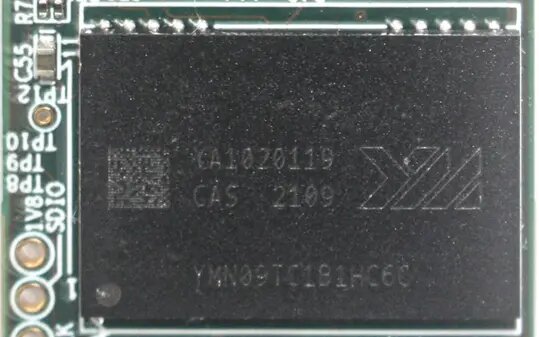Benchmarks of the PCIe 4.0 SSD Asgard AN4 come from Asia. The special feature of the M.2 SSD with heat sink is the NAND flash, because this comes from YMTC, the first Chinese NAND flash manufacturer. In comparison with Micron's new 176-layer generation and BiCS4 from Kioxia, the YMTC-NAND performs very well according to the test.
The tests were carried out by the user storage geek ( according to machine translation), who shares his experiences on the video portal Bilibili mostly in written form.
3D-TLC-NAND from YMTC, Micron and Kioxia in comparison
In addition to the Asgard AN4 with IG5236 controller and the aforementioned YMTC-NAND with 128-layer architecture in the TLC variant X2-9060, two further, unnamed SSDs with IG5236 controller were tested, one with Micron's 176-layer, according to the description -TLC-NAND (B47R) and once with the BiCS4-TLC-Flash (96 layers) from Kioxia and Western Digital. With the same controller, the test should enable a direct comparison between the three different NAND memories; however, the results only apply to the respective combination with this controller and do not only measure the performance of the NAND flash. The YMTC-NAND has the identifier YMN09TC1B1HC6C.



Asgard AN4 SSD with YMTC NAND (Image: Bilibili)
In the frequently used CrystalDiskMark, used here in the older version 6.02, the Asgard AN4 with YMTC-NAND delivers almost 7,500 MB/s in sequential reading and almost 5,500 MB/s in sequential writing and is thus on par with the model with Micron-NAND practically on par, while the somewhat older Kioxia NAND with a slower NAND interface is, as expected, behind. When reading and writing freely with 4KiB Q1T1, YMTC is just ahead of Micron and just behind Kioxia.
 Asgard AN4 SSD with YMTC NAND (picture: Bilibili)
Asgard AN4 SSD with YMTC NAND (picture: Bilibili) According to the information, the Chinese 3D-NAND also does very well in further tests, and is sometimes even at the top. However, the comparative values do not always appear to be consistent. Micron's 176-layer NAND in particular does surprisingly poorly in some cases. In the PCMark 10 Full System Drive benchmark, for example, the Bilibili user only achieved 2,352 points, while other testers also managed over 3,300 points (albeit with a different controller) with Microns B47R.
Micron does surprisingly badly
In any case, Micron's B47R with high throughput and low latencies is actually very fast, at least in combination with the E18 controller from Phison. Why the Micron NAND does so badly in the test from Asia with the IG5236 controller remains unanswered for the time being. Many factors play a role in SSD tests and a different firmware, a different port on the mainboard or even the order of the test series as well as the length of the pauses between the tests can influence the results and destroy the comparability.
A first exclamation mark for the performance
Even if this first known test of the YMTC -NAND does not appear conclusive at every point, this is an exclamation point. Further tests with the 3D-NAND from China can be eagerly awaited. It also remains to be seen how the YMTC storage system performs in other disciplines such as durability, energy requirements and, last but not least, costs. According to unconfirmed reports, the yield from the production of the 128-layer NAND from YMTC is still below expectations.
How well YMTC is financially positioned for the future has to be determined also show first. Because the Tsinghua Unigroup, to which YMTC also belongs, has accumulated over 30 billion US dollars in debt and is facing bankruptcy proceedings.

